Global Warming Affects Water In the Villages of Senegal
Dear World Family,
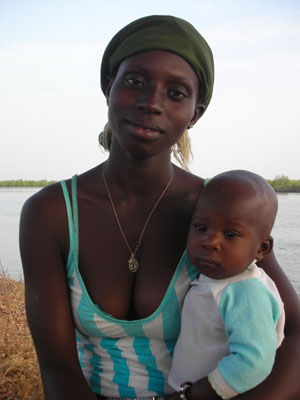 A few weeks go, I returned from West Africa. In Senegal, I was reminded that the world is really such a small place, and the things we need to be grateful for are so pure and simple – water.
A few weeks go, I returned from West Africa. In Senegal, I was reminded that the world is really such a small place, and the things we need to be grateful for are so pure and simple – water.
I went there at first to join my friend, photojournalist Catherine Allport, whose photo-essay of the apartheid in South Africa had toured Africa and Europe. I traveled there with another friend, activist musician, Edie Hartshorne, who is also the outreach coordinator for the World Wheel Project. Our intention was to build a meditation center and retreat on land Catherine purchased on the Senegal seashore. As it turned out, the land she thought she purchased belonged to someone else… I had come to donate and design a well there but instead we had landed in Senegal robbed of purpose.
I told her, “When one door closes, there is always another one ready to open that is more appropriate for us, and perhaps more magical.”
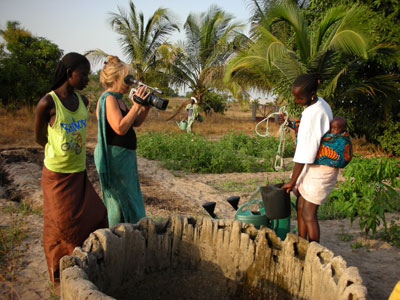 She had some legal battles to fight and a sense of loss about the land. We believed there must be a reason we were standing in this beautiful land of fragrant flowers and tall elegant villagers. A door was knocking to be opened. As we looked out at the Senegalese, their gentle seaside, and river veined region of the Casamance, we sought to find the answer. I did not expect the trip to Senegal to be an extension of my World Wheel Project.
She had some legal battles to fight and a sense of loss about the land. We believed there must be a reason we were standing in this beautiful land of fragrant flowers and tall elegant villagers. A door was knocking to be opened. As we looked out at the Senegalese, their gentle seaside, and river veined region of the Casamance, we sought to find the answer. I did not expect the trip to Senegal to be an extension of my World Wheel Project.
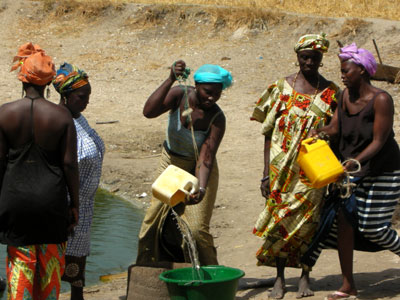 Suddenly, I was standing in Senegal, Africa looking out at the strong dignified faces of the women and men whose villages bordered a network of rivers.
Suddenly, I was standing in Senegal, Africa looking out at the strong dignified faces of the women and men whose villages bordered a network of rivers. I found myself, as I have in every other place I have journeyed, asking the inhabitants the same three questions. I posed these to myself as I matured from childhood and carried them with me as I traveled with the World Wheel Project:
What is your essence?
What is you problem?
What is your solution?
And their response: Water. Water. Water. It surrounds us. It is us. It is our problem. It is our answer.
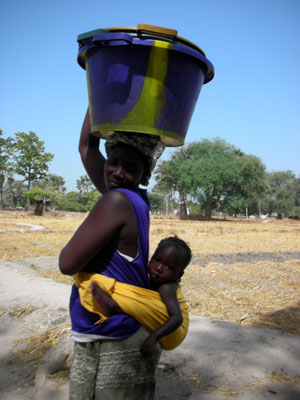 Senegal located on the sea, is a region full of rivers. It is as much a gift as it is a painful legacy. It was on these tributaries that slaves were cast out to the waves and chained for the Americas. Water is everywhere, but ironically not accessible, and of little use to the women who must walk miles to the wells or ponds to get access to desalinated and potable sources.
Senegal located on the sea, is a region full of rivers. It is as much a gift as it is a painful legacy. It was on these tributaries that slaves were cast out to the waves and chained for the Americas. Water is everywhere, but ironically not accessible, and of little use to the women who must walk miles to the wells or ponds to get access to desalinated and potable sources.
Because of global warming the ocean has risen and the drought in the area has shrunk the rivers, bringing in the salt water with each belch of the tides. The riverlets are now saltier than the ocean and the wells have become salty, some of the rice fields cannot bear crops, and the mangroves along the banks are dying.
One Senegalese woman dressed in the traditional brightly colored fabrics, a baby tied to her back with a matching scarf and a tub of water (perhaps 60 pounds) on her head says, “We walk several kilometers one way to the wells.”
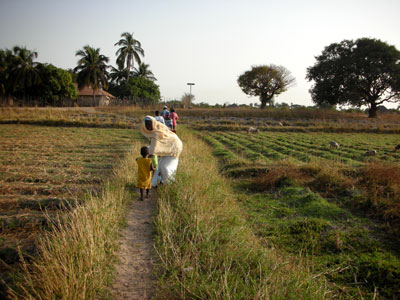 “No one has ever asked us what we need or want,” said another villager. “Our days are spent in search of water…we need wells, encatchments for water, we need to desalinate the water we have…we need good wells for our gardens and families. We have been alone with our problems. No one has ever seemed to care.”
“No one has ever asked us what we need or want,” said another villager. “Our days are spent in search of water…we need wells, encatchments for water, we need to desalinate the water we have…we need good wells for our gardens and families. We have been alone with our problems. No one has ever seemed to care.”
The school-teacher present translated her Jola tongue into French, and then Edie with her fluent French translated his French into English. Because of their family’s pressure, many women in the villages work the rice fields, carry water, take care of the children, cook, grow gardens, and have not been to school and only speak their African tongue.
 “You are our sisters!” exclaimed another person in Jola. “This is your home too now!” she said as she stood clapping her hands, “No one has ever come to ask us about our problems. Welcome home to you!”
“You are our sisters!” exclaimed another person in Jola. “This is your home too now!” she said as she stood clapping her hands, “No one has ever come to ask us about our problems. Welcome home to you!”
She leapt into the middle of our circle and danced with the energy of a lioness, her arms wildly cutting the air and her feet pounding the earth with the reds and yellows of her skirt blinding as if in a Mix-master. One by one, the women leapt up dancing their wild dance of appreciation as the others sang and clapped in rhythm.
Synchronicities and Soroptomists
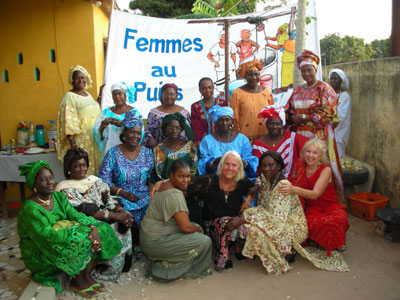 We settled for a few days in Ziguinchor as we shifted plans. With our newly defined mission of learning more about water and the needs of the people there, we decided we would rent a pirogue (a Senegal fishing canoe.) We set out to learn more from the riverside villagers. In Ziguinchor we exchanged our dollars for CFAs and Catherine finalized the painful details of her lost property. As we had no itinerary, we had no idea where we were headed next until we were standing in line to check into our hotel.
We settled for a few days in Ziguinchor as we shifted plans. With our newly defined mission of learning more about water and the needs of the people there, we decided we would rent a pirogue (a Senegal fishing canoe.) We set out to learn more from the riverside villagers. In Ziguinchor we exchanged our dollars for CFAs and Catherine finalized the painful details of her lost property. As we had no itinerary, we had no idea where we were headed next until we were standing in line to check into our hotel.
Catherine began chatting with a woman who turned out to be the International President of the Soroptomist Society, and she introduced us to other women who had come to Senegal to investigate the problems with water.
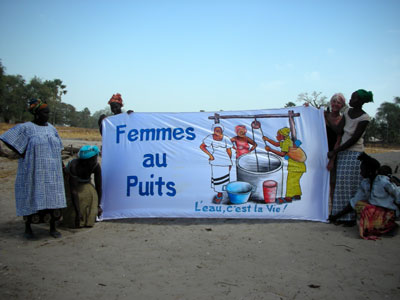 We told them of our plans to travel to the different villages and hear their unique stories, as we would learn even more of what was needed in the outlying communities near the banks of the river. We set up a meeting for when we would return with the Soroptomists and local leaders to discuss how all of us might best serve Senegal’s people.
We told them of our plans to travel to the different villages and hear their unique stories, as we would learn even more of what was needed in the outlying communities near the banks of the river. We set up a meeting for when we would return with the Soroptomists and local leaders to discuss how all of us might best serve Senegal’s people.
As the door slammed shut on Catherine’s dream of a seaside meditation retreat, another had opened. We climbed through the portal into the vast space of the Casamance River where the tides brought us into new lands, and to the voices of others who had stories to tell of their drying gardens and the changing landscape of drought and rising seas.
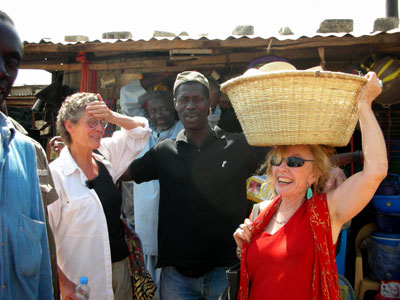 As a kind of christening, we came up with the name “Femme Au Puits, L’eau C’est La Vie” (Women at the Well-Water is Life) and one Senegalese artist painted a powerful banner for us, with our chosen name and hree Senegalese women around a well.
As a kind of christening, we came up with the name “Femme Au Puits, L’eau C’est La Vie” (Women at the Well-Water is Life) and one Senegalese artist painted a powerful banner for us, with our chosen name and hree Senegalese women around a well.
The Casamance River: Pirogue and Starlight
We traveled the Casamance River in our pirogue. These distinctive vessels, which can also be found on America’s bayous, are made from hollowed wood and are wide and sturdy enough to become not only a means of transport, but a foundation of shelter on water. We reinforced the floor and brought in blankets to create beds. This way we could lay on our backs at night, lulled by the currents of the Casamance and the cries of birds, as we looked up at the expansive sky.
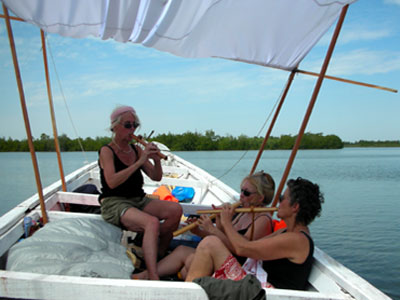 Catherine invited her friend Boniface, a tall calm Sengalese man, with a low voice and air of selflessness, devoted to Catherine’s work. He was escorted by a much younger man, Honré, who became our pirogue guide. Together, we sang, played flutes, and chatted, and sat in reverent silence as we sailed the leaf-veiled riverways.
Catherine invited her friend Boniface, a tall calm Sengalese man, with a low voice and air of selflessness, devoted to Catherine’s work. He was escorted by a much younger man, Honré, who became our pirogue guide. Together, we sang, played flutes, and chatted, and sat in reverent silence as we sailed the leaf-veiled riverways.
As we left the bank, we did not hear one motor or rumble of another boat. A great heron and several African river eagles flew out of the mangroves bordering the rivers. Honré caught fish for our supper and we could see oysters on the bush roots of the mangroves anchored into the river. After hours of traveling we banked on the outskirts of a village and as oysters were being roasted over a bond fire, we were invited by the villagers to share.
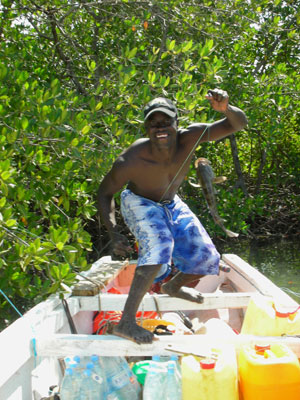 The food, the air, the earth of Senegal have not been polluted. Only hints of environmental damage were in the salinated rivers and rising tides impacted by global warming. Otherwise, the beauty and vastness of the Casamance invited a commitment within me. I felt called to be a steward to this land and water, and I would do all I could to serve its people that have grown from a kind Muslim culture sprinkled with Christianity and Animist leanings, committed to their families and community.
The food, the air, the earth of Senegal have not been polluted. Only hints of environmental damage were in the salinated rivers and rising tides impacted by global warming. Otherwise, the beauty and vastness of the Casamance invited a commitment within me. I felt called to be a steward to this land and water, and I would do all I could to serve its people that have grown from a kind Muslim culture sprinkled with Christianity and Animist leanings, committed to their families and community.
The Senegalese have no homeless; a quality of generosity infuses all aspect of their lives; although many are on the verge of starvation because of drought, salt water, rising food prices, and no work available in this non industrial land. No matter how little people have, it is always shared.
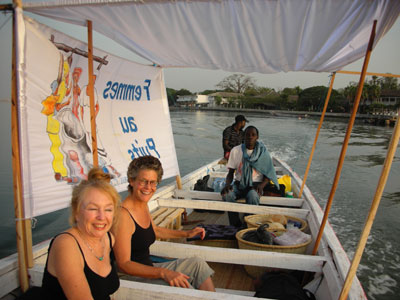 We first journeyed in our pirogue to the village Oussouye where the King of the Jola tribe lived to ask for his blessings.
We first journeyed in our pirogue to the village Oussouye where the King of the Jola tribe lived to ask for his blessings.
He received us in the innermost courtyard of his humble “palace,” made of trees, bamboos, and hanging vines with large tropical flowers. He sat on a wooden stool holding his staff, a humble broom made of grass stalks, signifying “Peace not War—domestic concerns rather than building armies.”
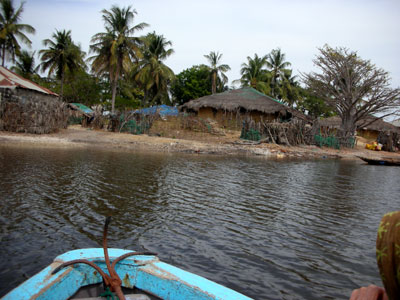 We were prompted to bring palm wine that would later be shared with the village. He prayed for the wellbeing of our project in Jola, and each phrase was echoed in approval by his entourage. Later, we found out that the food and resources that are brought to him, are not his. When someone in the village does not have enough food or is ill, he will send one of his emissaries in the middle of the night, to leave food at the family’s back door, so the gift is made privately. No one goes without and no one is shamed for needing. What is given to the king by the community is returned back to his people in times of need. This kind of community and caring is stunning.
We were prompted to bring palm wine that would later be shared with the village. He prayed for the wellbeing of our project in Jola, and each phrase was echoed in approval by his entourage. Later, we found out that the food and resources that are brought to him, are not his. When someone in the village does not have enough food or is ill, he will send one of his emissaries in the middle of the night, to leave food at the family’s back door, so the gift is made privately. No one goes without and no one is shamed for needing. What is given to the king by the community is returned back to his people in times of need. This kind of community and caring is stunning.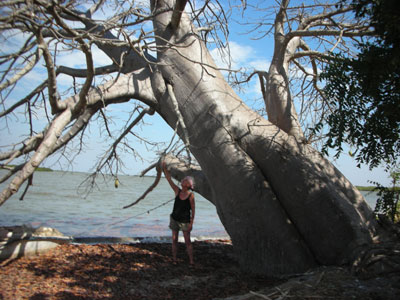 After traveling in our pirogue to many villages, and hearing their cries for water, we stumbled upon a village with a queen. We were led into her simple chamber, followed by the custom of bowing in front of her and touching our hands to our heart. She prayed in Jola, for our safety and the fulfillment of our project with her prayer being echoed with what might have been an equivalent of an “amen.” She asked us to stay the night so that she could gather the women the next morning for us to ask our questions.
After traveling in our pirogue to many villages, and hearing their cries for water, we stumbled upon a village with a queen. We were led into her simple chamber, followed by the custom of bowing in front of her and touching our hands to our heart. She prayed in Jola, for our safety and the fulfillment of our project with her prayer being echoed with what might have been an equivalent of an “amen.” She asked us to stay the night so that she could gather the women the next morning for us to ask our questions.
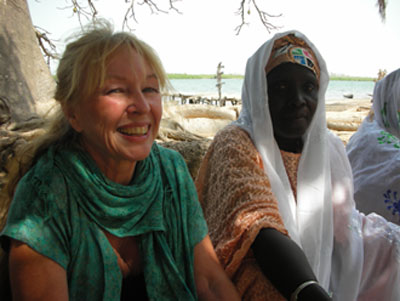 This night we slept in our pirogue to the tossing of waves because of a gale from the direction of the ocean.
This night we slept in our pirogue to the tossing of waves because of a gale from the direction of the ocean.
The next morning we all gathered with the queen in a circle of women under the baobab tree in her village. The baobab, is Africa’s most characteristic tree and is nicknamed the “upside down tree.” It is deemed to be sacred and is believed to have magical powers. Legend has it that a displeased deity plucked a tree in anger and thrust it back into the ground upside down thus the massive trunk and twisted branches.
T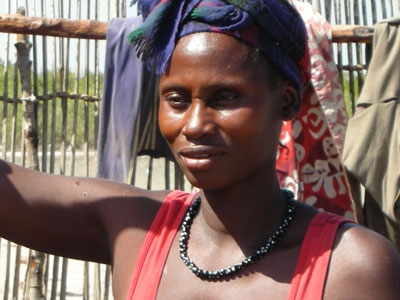 he hollow trunk can hold rainwater and the tree’s large pods contain furry seeds encased in a sherbet-like substance that can be eaten or made into a drink. Its furry fruit is a true survivor in dry, hostile climates.
he hollow trunk can hold rainwater and the tree’s large pods contain furry seeds encased in a sherbet-like substance that can be eaten or made into a drink. Its furry fruit is a true survivor in dry, hostile climates.
The bark is used to make rope and the leaves add flavor to local dishes. Many say its pulp is delicious and good for the skin. The baobab tree is scattered everywhere, some on the banks, some inland, and some in village.
We were greeted with the words “Kasumie? Kasumie?” (“How are you? How are you?”) When the women gave their reply for their needs, “water” — touched that we even asked the question itself — each woman leapt into the center of our circle in a wild dance of enthusiasm and appreciation.
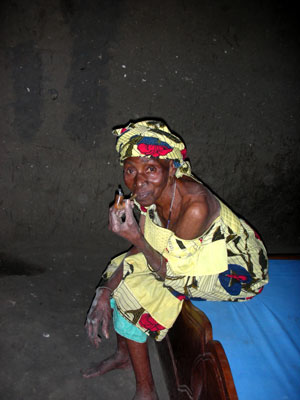 The next day we anchored our pirogue and waded through the tide of the river. The silence pierced our ears as we walked in what appeared to be an abandoned traditional Senegalese village at the end of a winding narrow waterway lined in mangroves. Catherine and Edie walked in front of me and I saw them tuck their cameras back in their bags, thinking no one could possibly live in these crumbling mud houses patched and repatched with pieces of metal, plastic, rotting wood, and cloth.
The next day we anchored our pirogue and waded through the tide of the river. The silence pierced our ears as we walked in what appeared to be an abandoned traditional Senegalese village at the end of a winding narrow waterway lined in mangroves. Catherine and Edie walked in front of me and I saw them tuck their cameras back in their bags, thinking no one could possibly live in these crumbling mud houses patched and repatched with pieces of metal, plastic, rotting wood, and cloth.
Just then an elder opened a half-hinged wooden door and stepped forward to greet us in her native tongue, Wolof, “Naca suba ce!” Her head was cradled in a bright purple scarf, a bit of grey hair showed between folds. Her midnight black skin was rough as we shook hands. “The men are out fishing,” translated our guide, and we were led to another group of dilapidated houses to find an old man sitting under a baobab tree wearing a T-shirt full of holes, but enough intact to show Bin Laden’s face peering out at us. Edie leaned down to show him, in the screen of her digital camera, the picture she just took of him. He doubled over with laughter!
We all walked to the sacred tree where the women come to pray for a child, or the health of a relative, or WATER. The old man stood for a moment, then said, “This side of the tree is for the women, this for the men, and this wooden drum in the center is only played at ceremonies.”
We three women sat on the sprawling network of roots from the kapok tree, or fromager as it is called in Senegal, and made our prayer, “May we be guided to find the right tools and ways to help our growing Senegalese family.” The old man along with Boniface and Honré, sat across from us under a tree that had a fetish hung from a branch. We gazed at the net that hung from the tree containing bones and odd objects. “This is part of the fetish brought here from where we used to live.”
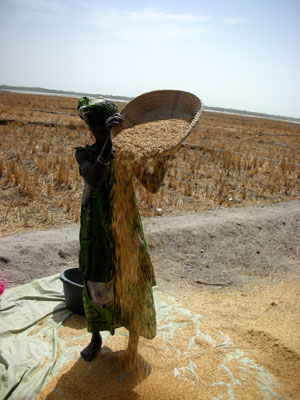
“The village used to be there.” The old man pointed a finger across the receding tide that sucked the water canals dry at the ends and belched its waters out to the sea. “Over there on the other shore we had a well and a spring of fresh water, but we didn’t get along with the fetish, with the spirit of the land. We moved here where there is no water. Everyday when the tied is low, we walk across the river, then carry our water back in these containers to our village here,” pointing to the yellow gasoline can by his side. “Here we don’t get sick. We are living in peace.”
We started out across the mud bottom river that was now only one foot deep, across sand bars, leaving behind the silent village that had never known a car, a radio or light bulb — and finally arrived where our boat had been pulled to the edge of the receding waters. We climbed in as our smiling host, who had come with us, showered us with dried fish—and I wondered, as we pulled away, “Did we leave enough for them?”
 As the motor noise of our boat filled the silent spaces, so precious and rare in our lives, I thought about the poverty in Senegal. At first seemed overwhelming and devastating to the lives here. I began to see their lives, dimly at first, as the sun filters through the green leaves of the mangrove, bit by bit opening up patterns of light and understanding. I see that their lives are a rich fabric of family, beliefs, comradeship in working the land, fishing, raising children, listening to the whispers of nature as they breathe in and out with the tides.
As the motor noise of our boat filled the silent spaces, so precious and rare in our lives, I thought about the poverty in Senegal. At first seemed overwhelming and devastating to the lives here. I began to see their lives, dimly at first, as the sun filters through the green leaves of the mangrove, bit by bit opening up patterns of light and understanding. I see that their lives are a rich fabric of family, beliefs, comradeship in working the land, fishing, raising children, listening to the whispers of nature as they breathe in and out with the tides.
As we motored back to our original landing, we spotted a snake-bird nesting in the mangrove then fly startled out of its perch with the invasion of us foreigners. I think of Mother Teresa’s words, “…then we realize that we are the ones living in poverty…”
As the time came to end our journey, we gave money to the women for three village wells. These small gifts offered many blessings, and we promised we would return to bring more help.
The River of Life Runs Through Us
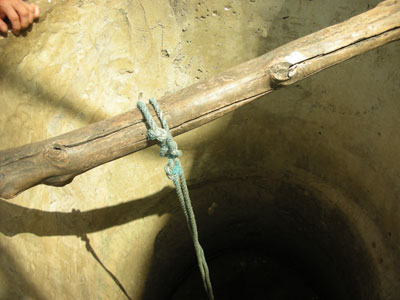 Purchasing a well is a very small act, costing only $400 USD and what a huge difference this well makes to the village.
Purchasing a well is a very small act, costing only $400 USD and what a huge difference this well makes to the village.
The Casmanace and its people offer a gift that endures in the three of us who visited there; the river that runs through us, joins us to people all over the world. Water is, indeed, life, and we are all connected to its source.
From my book, World Wheel, One Woman’s Quest for Peace:
Click here to purchase the book, World Wheel
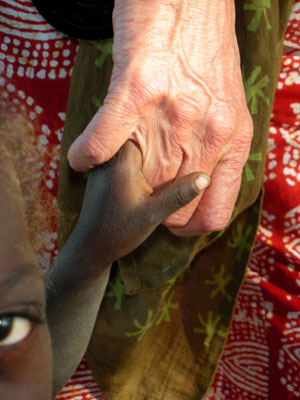 The world became my studio. I am a pilgrim and continue to make offerings and give voice and form to the spirit of the earth, along with the people I meet on the journey. I expand the borders of what sculpture is, what art is, integrating it more and more into life itself — the people, their problems, their hopes, and their dreams of the future.
The world became my studio. I am a pilgrim and continue to make offerings and give voice and form to the spirit of the earth, along with the people I meet on the journey. I expand the borders of what sculpture is, what art is, integrating it more and more into life itself — the people, their problems, their hopes, and their dreams of the future.
I see that at the root of these problems is the misunderstanding of ourselves as separate, isolated beings needing to exploit the earth and each other for our personal gain. This dualistic way of thinking is the direct cause of our ecological and social problems, which are rapidly leading us toward global disaster.
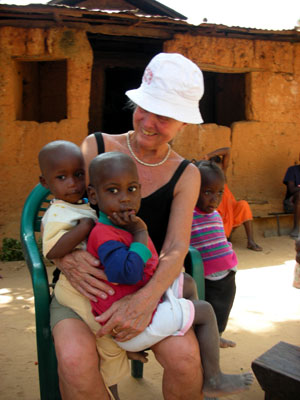 I leave you with these thoughts and a prayer that our planet may be a healthy space for our children, our children’s children and their children’s children — and that peace may prevail on earth through an open hearted interaction with cultures that are different from our own.
I leave you with these thoughts and a prayer that our planet may be a healthy space for our children, our children’s children and their children’s children — and that peace may prevail on earth through an open hearted interaction with cultures that are different from our own.
For twenty-four years I have circled the planet to aboriginal destinations, offering ritual art, starting grass roots projects to help the communities, and the gifts of my heart as a pilgrim for peace.

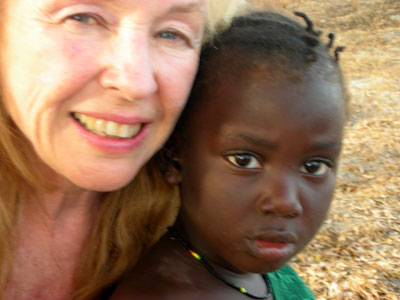
NOTES AND PHOTO CREDITS
Top Banner:
Photo by Vijali Hamiton — Four Faces of Unity (detail) in Seneca Reservation
Photo by Vijali Hamiton — Woman Of Space Pregnant With Sun in Spain
Photos by Edie Hartshorne:
Photos by Vijali Hamilton:
Photos by Honré:
Photo by Catherine Allport
Soroptomist Society with Edie and Vijali
